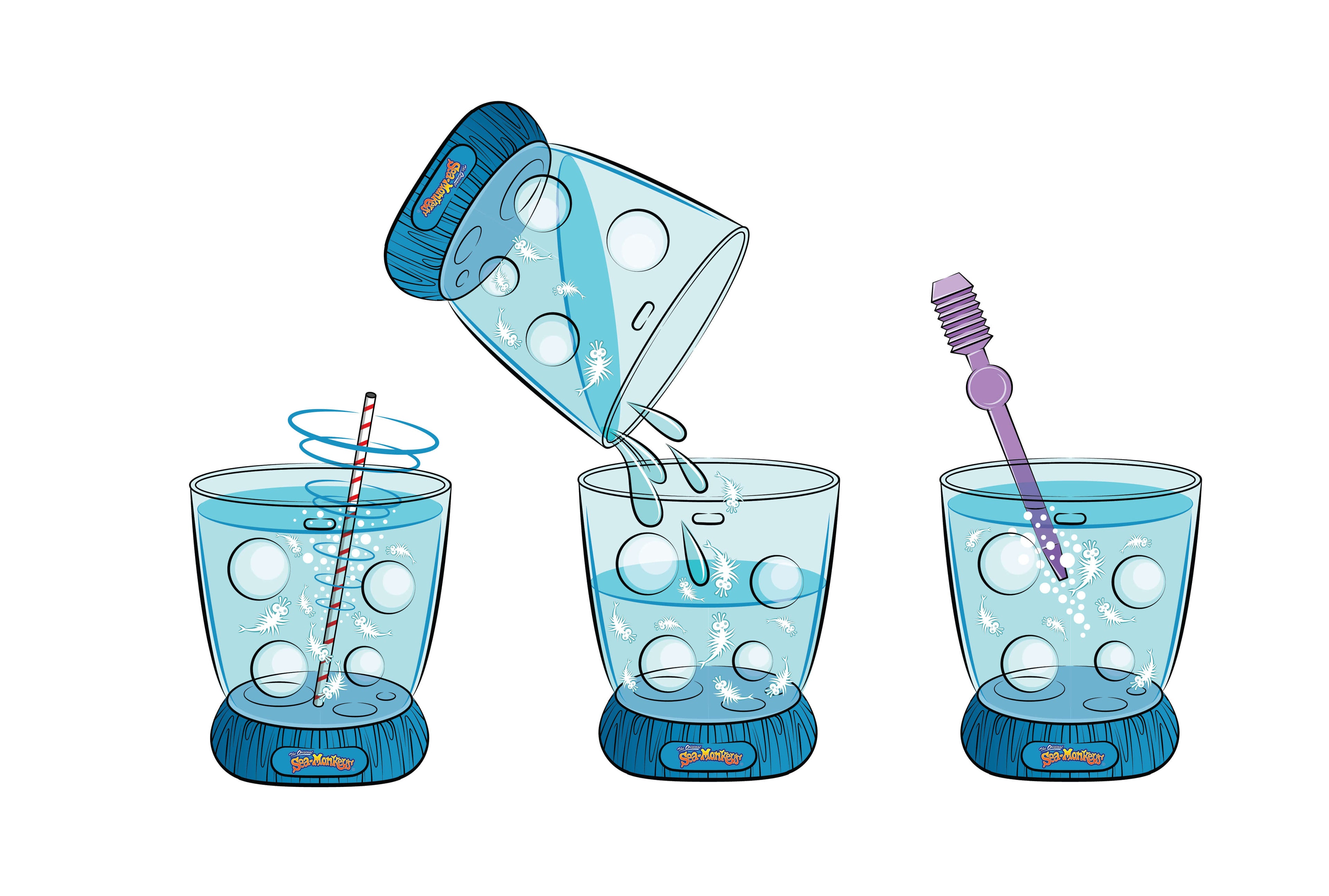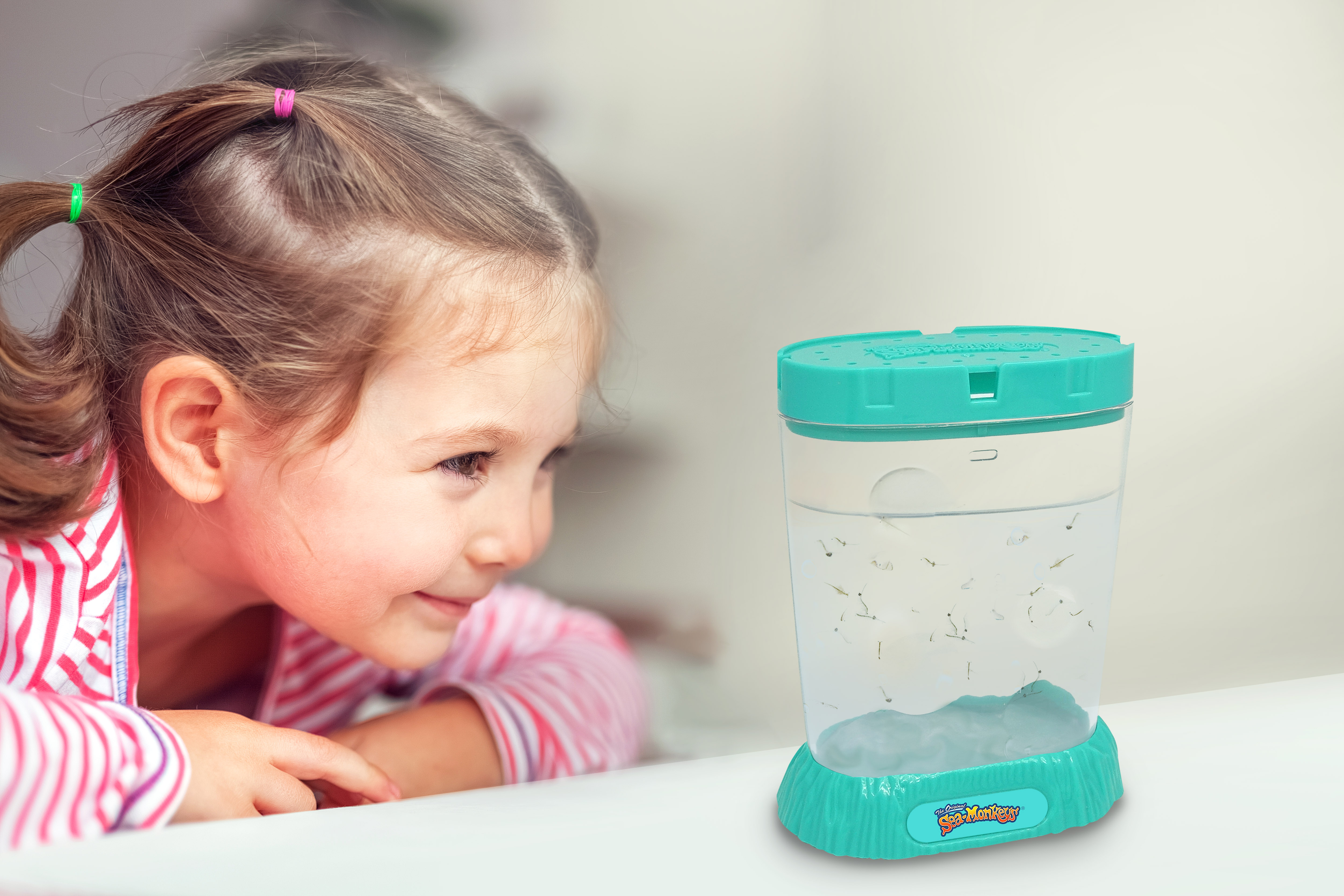day to day care
Sea-Monkeys® live best in constant environments at room temperatures between 70°F to 79°F (21°C-26°C), and find extreme fluctuations in temperature to be most harmful to their existence.
They will adapt to cooler climates such as those found in Northern Europe and Canada. If raised at lower temperatures, their growth rate and size may be slightly impeded. This will NOT affect their life-span. They will live just as long as their brothers and sisters raised in warmer temperatures.
Exposure to daylight is helpful.They will enjoy frolicking in the sunlight as long as it doesn’t overheat their water.
The light also stimulates green algae or brown diatom growth (live microscopic cells that Sea-Monkeys® eat in nature). Green algae (a plant) is especially beneficial because it produces oxygen as well as acting as a great food source. Consider keeping them under a “grow light” during the day, turning it off at night to give them time to rest. Grow lights illuminate the water and encourage the growth of algae. They are inexpensive and readily available online.

WATER AERATION:
All living creatures need oxygen to survive and Sea-Monkeys® are no exception. But how do you get additional oxygen in their water? This can be accomplished in several different ways;
- The best way to add oxygen to their water is by pouring the entire contents of their tank back and forth into another clean container. Don’t worry about hurting your little friends, they will enjoy the ride and it will give them a breath of fresh air. Weekly aerating sessions are recommended. When algae is present, it will produce oxygen naturally as well as providing a delicious food source.
- If your Sea-Monkey® kit comes with an aqua-leash or million-bubble air-pump, those are ideal devices to add oxygen to their tank.
- Stir their water with a sterile plastic spoon, straw, or swizzle stick. This will help but is the least effective way.
WATER EVAPORATION:
It is natural for the water in your Sea-Monkeys® container to evaporate slowly.
When the water level drops by 2 inches (5 cm), replace it with room temperature distilled or bottled water and scoop out any contaminants that may have found their way into the tank. No additives are needed. As the water evaporates, the salts and minerals in the formula become concentrated. This helps the Sea-Monkeys® to molt their shells during the growing process and helps perpetuate the natural life cycle. Sea-Monkeys® do not have internal bones like vertebrates (animals with backbones) do. This includes fish, reptiles, birds and mammals. Their skeletons grow internally. Sea-Monkeys®’ skeletons are on the outside of their body in the form of a shell. The term for this is “exoskeleton,” meaning “skeleton on the exterior.”
As your Sea-Monkeys® grow, they will cast off their old shell (or exoskeleton) and grow a new one. Each time this happens, they get larger and the new shell hardens and thickens over the soft tissue that covers their bodies.
BREEDING SEA-MONKEYS®:
Once Sea-Monkeys® have reached the adult stage of growth, they will begin breeding by themselves. However, there are some things that you can do to encourage their maximum breeding potential. As an example, at room temperatures (in the 65°F to 75°F (18°C-24°C), the mating tendency will be at its highest point. At lower temperatures, they will rarely mate. When breeding, the male Sea-Monkey® pairs himself with a willing female by grasping her at the root of her tail (where it joins her torso.)
THE UNBREAKABLE “CHAIN OF LIFE!”
Sea-Monkeys® reproduce like other advanced animal species. A male Sea-Monkey® and a female Sea-Monkey® mate sexually, and thus new life is created. Lesser forms of life such as hydra and other simple animals reproduce through budding — or even through mitosis (splitting in two) which occurs among single-celled animaculae (micro-animals) such as Amobee and Paramecium. Among Sea-Monkeys® however, in the absence of a mate, a strange, wonderful thing happens. Incredible as it may seem, some female Sea-Monkeys® bear offspring arthenogenises or self-conception!
troubleshooting
Why Can't I Grow My Sea-Monkeys?
Sea-Monkeys® really aren't hard to raise at all. First, you have to prepare the water. Most people mix everything together at once and expect the Sea-Monkeys® to be born. Well, you don't get anything but a jar of dirty water if you do that. Here's some tips to keep them alive.
- Follow the directions that come with them
- Don't overfeed them; once every 7 to 10 days is fine
- Use Distilled water or Bottled water to start and top up levels
- Keep the water in your aquarium at the same level
What if your Sea-Monkeys® do NOT hatch instantly?
If your Sea-Monkeys DO NOT HATCH ON TIME, check the following list to FIND THE REASON. Do not make the mistake of throwing out the water if you do not see them at first. Remember, except for ONE CHANCE in a MILLION, your Sea-Monkeys® ARE ALIVE and well! These emergency instructions will solve any problem you may have.
Did you look very closely?
Your failure to SEE them is one of the COMMONEST reasons for thinking they did not hatch. When born, Sea-Monkeys® are as tiny as a pinpoint sized "dot" of white. Also, very FEW may hatch at first, and THESE may be hiding among other particles in the water. You must SEARCH very carefully, in plenty of light, for the tiniest of MOVING specks that wiggle and swim.
Did you wait the full 24 hours before adding Packet No. 2?
They will NOT hatch ON TIME if you fail to WAIT LONG ENOUGH for the water, purified with Packet No. 1, to CURE. After you have added Water Purifier, you must not put in Packet No. 2 until AT LEAST 24 to 36 HOURS have passed. This gives the Water Purifier chemicals the time needed to eliminate toxic elements and prepare the INSTANT "reactor" catalyst that makes the Sea-Monkeys appear to hatch ON CONTACT with the water. If you added Packet No. 2 TOO SOON, set the container aside for ONE DAY. You will have your Sea-Monkeys on the SECOND DAY.
Did you accidentally add Packets No. 1 and No. 2 at the same time?
If you added BOTH Packets No. 1 and No. 2 to the water at the SAME TIME, the Sea-Monkeys CAN NOT HATCH INSTANTLY. This mistake will NOT ruin your attempt to produce them, fortunately. Set the container aside for TWO DAYS. You will have your Sea-Monkeys® on the THIRD DAY.
Did you use the correct amount of water?
Sea-Monkeys® WILL NOT HATCH if you measured the WRONG AMOUNT OF WATER that should be used. You must use EXACTLY 12 ounces of water to get Sea-Monkeys to hatch "on the button." Failure to use the RIGHT QUANTITY of water will NOT ruin the experiment. It WILL however cause a DELAY.Too little water:If YOU used too LITTLE water, simply add MORE to arrive at the RIGHT AMOUNT (12 ounces).Too much water:If you OVER DID IT and added TOO MUCH water, let the container STAND until it has EVAPORATED to the proper amount. DO NOT DRAIN OFF excess water. The QUANTITY of formula provided in the two Packets, No. 1 and No. 2 is the amount of chemicals needed for 12 ounces. Too much water DILUTES the formula. Too little water CONDENSES it.Note: All styles of the Micro-Vue Ocean-Zoo hold just the right amount of water when filled to the top of the highest magnification lens on the Ocean-Zoo's outer wall.
Is the room temperature correct?
Incorrect ROOM TEMPERATURE can DELAY hatching. Ideally, the temperature should be 70 degrees Farenheit. Lower temperatures of 60 degrees F. or less, or rapid temperature changes WILL delay the hatching time AFTER you have added Packet No. 2, Instant Live Eggs, according to the instructions. If this is your problem, put the container in a light, warm area, and let it stand undisturbed. You will have your Sea-Monkeys within TWENTY-FOUR HOURS.




